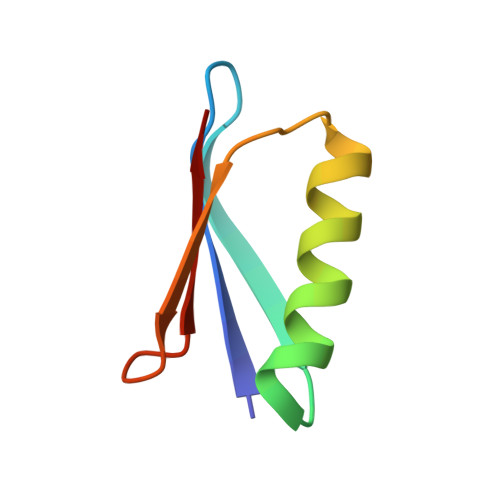Evaluation of backbone proton positions and dynamics in a small protein by liquid crystal NMR spectroscopy
Ulmer, T.S., Ramirez, B.E., Delaglio, F., Bax, A.(2003) J Am Chem Soc 125: 9179-9191
- PubMed: 15369375
- DOI: https://doi.org/10.1021/ja0350684
- Primary Citation of Related Structures:
1P7E, 1P7F, 2OED - PubMed Abstract:
NMR measurements of a large set of protein backbone one-bond dipolar couplings have been carried out to refine the structure of the third IgG-binding domain of Protein G (GB3), previously solved by X-ray crystallography at a resolution of 1.1 A. Besides the commonly used bicelle, poly(ethylene glycol), and filamentous phage liquid crystalline media, dipolar couplings were also measured when the protein was aligned inside either positively or negatively charged stretched acrylamide gels. Refinement of the GB3 crystal structure against the (13)C(alpha)-(13)C' and (13)C'-(15)N dipolar couplings improves the agreement between experimental and predicted (15)N-(1)H(N) as well as (13)C(alpha)-(1)H(alpha) dipolar couplings. Evaluation of the peptide bond N-H orientations shows a weak anticorrelation between the deviation of the peptide bond torsion angle omega from 180 degrees and the angle between the N-H vector and the C'-N-C(alpha) plane. The slope of this correlation is -1, indicating that, on average, pyramidalization of the peptide N contributes to small deviations from peptide bond planarity (
= 179.3 +/- 3.1 degrees ) to the same degree as true twisting around the C'-N bond. Although hydrogens are commonly built onto crystal structures assuming the N-H vector orientation falls on the line bisecting the C'-N-C(alpha) angle, a better approximation adjusts the C(alpha)-C'-N-H torsion angle to -2 degrees. The (15)N-(1)H(N) dipolar data do not contradict the commonly accepted motional model where angular fluctuations of the N-H bond orthogonal to the peptide plane are larger than in-plane motions, but the amplitude of angular fluctuations orthogonal the C(alpha)(i-1)-N(i)-C(alpha)(i) plane exceeds that of in-plane motions by at most 10-15 degrees. Dipolar coupling analysis indicates that for most of the GB3 backbone, the amide order parameters, S, are highly homogeneous and vary by less than +/-7%. Evaluation of the H(alpha) proton positions indicates that the average C(alpha)-H(alpha) vector orientation deviates by less than 1 degrees from the direction that makes ideal tetrahedral angles with the C(alpha)-C(beta) and C(alpha)-N vectors.
Organizational Affiliation:
Contribution from the Laboratory of Chemical Physics, National Institute of Diabetes and Digestive and Kidney Diseases, National Institutes of Health, Bethesda, MD 20892, USA.













